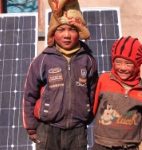In recent years, China has emerged as the world’s largest manufacturer of solar photovoltaic (PV) panels. Driven largely by strong demand in Europe, almost all of the solar panels manufactured in China have been exported to overseas markets. However, the current global financial crisis, coupled with recently dampened financial incentives for solar power in some parts of Europe, has significantly contracted overseas markets. The solar manufacturing industry in China is, as a result, under intense pressure to fend off what appears to be a bursting “bubble.” By promoting China’s domestic solar market, however, the Chinese government is presented with a unique opportunity to sustain the domestic solar industry, create more jobs, and enhance energy and environmental security. To be spurred into action, however, China’s planners must appreciate the true value proposition of solar, understand the present bottlenecks limiting solar deployment, and respond with appropriate policy actions to overcome these hurdles so as to create a vibrant domestic solar market.
Few issues keep China’s national planners awake more than energy and environmental security. According to Cambridge Energy Research Associates, China obtained 80% of its electricity generation from coal in 2007. As the strains of a coal-based energy structure are being felt, China faces an enormous economic, environmental and social balancing act. China’s planners feel the necessity to take advantage of China’s plentiful coal resources to ensure a supply of affordable and reliable power for its citizens, so as to maintain economic and social order. However, the geographic mismatch between China’s coal resources concentrated in the central and western regions, and where power is most used along the eastern coast creates long, unwieldy supply chains that are susceptible to disruptions, such as natural disasters. Logistical challenges posed by finite rail capacity mean that China relies heavily on coal imports to supply coal to certain parts of the country, particularly the southeast. Although China boasts a third of the world’s coal reserves, it became a net importer of coal for the first time in 2007.
The use of coal is plagued with unaccounted social costs and fuel price volatility. The health and environmental impacts of coal use are significant. In 2007 alone, some 3,786 coal miners died in mining accidents.The extraction, processing, transportation and combustion of coal produces significant water, air and solid residue pollution, with all its public health implications. With China soon, if not already, surpassing the United States as the largest emitter of greenhouse gases, and with the Kyoto climate treaty up for renegotiation, there is strong international pressure on China to actively reduce its emissions, to which coal-fired power is a major contributor. The proposition of coal as a cheap and reliable source of power is quickly losing influence, undermined by the combined economic risks from rising social costs and unpredictable coal prices, which have nearly halved since peaking at about 1,000 yuan (US$147) per tonne in mid-2008.
The need to diversify and clean up China’s power sources is not lost on the central government. It has undertaken a variety of measures, from the prioritisation of energy efficiency to the promotion of clean alternative energy development through the passage of the Renewable Energy Law in 2006. Solar energy represents a promising energy alternative that directly addresses many of the shortcomings of coal-fired power. China’s solar resources are abundant, averaging four kilowatt hours per square metre of radiation in most areas, representing a similar resource level to that of the United States and much more than that of Japan and Europe. However, while there has been enormous global investment interest in developing solar technologies over the past three years, limited government support and the recent sharp financial downturn has created uncertainties in the prospects for the mass deployment of solar energy systems in China. Yet, there may be a silver lining.
Amid the global financial downturn, three trends are causing solar PV module prices to decline steeply, leaving an opening for aggressive government action to promote the deployment of solar domestically.
First, the price of polysilicon feedstock, which is the key raw material in the predominant type of solar panels in the PV market, has declined significantly from a high of over US$400 per kilogram in mid-2008 to about $100 per kilogram by the end of the same year. The increased supply from newly completed polysilicon production plants planned for in the solar boom years of 2006 and 2007, together with the softening of overseas demand for solar panels and the expanding market share of non-silicon-based PV material, are expected to keep polysilicon prices depressed in 2009. Second, there has been a sharp decrease in solar module demand in western markets due to the global recession and a reduction in incentives for solar energy in key markets such as Germany and, especially, Spain. Worldwide revenue from the shipment of solar PV panels is projected to decrease by 20% in 2009 compared to the year before. Third, until the recent crimping of overseas markets, solar manufacturers were on a trajectory to expand production capacity and improve economies of scale. With the combined effect of reduced input costs, weakened demand and increased supply, solar module manufacturers are already reportedly slashing module prices by 30% to 40%. Meanwhile, facing a growing oversupply, many smaller Chinese solar manufacturers are struggling to remain in business.
In these uncertain times, government support is vital for the development and deployment of solar power. Currently, the domestic solar PV market is essentially non-existent. In 2007, more than 95% of the solar modules manufactured in China were exported.At the end of the same year, a mere 100 megawatts (MW) of solar power were installed (of which only 5 MW were of the distributed, roof-top sort), compared to about 6,000 MW of wind and 513,000 MW of coal. The root of government inaction in China and internationally is that when viewed in narrow economic terms, solar energy seems much more expensive than coal. In the face of China’s enormous environmental, energy and climate-change challenges, solar energy’s advantage as a clean and abundant energy source is widely recognised, but far less discussed are the efficiencies and other benefits over centralised coal power generation that solar can bring if used as a distributed energy resource. None of the foregoing “positive externalities” are currently valued into the price of solar.
Given the entrenched nature of China’s fossil fuel infrastructure, it is unrealistic for solar energy to significantly displace coal as the dominant electricity fuel source in the near or medium term, but the government can take advantage of the current unique financial situation to adopt measures that will significantly accelerate the utilization of domestic solar resources. There is a compelling national security case for developing China’s domestic solar market, but reaching this conclusion requires a better understanding of the true value of solar energy, economic or otherwise, of what makes it competitive or even superior to its fossil fuel counterparts.
Julian L. Wong is an energy analyst based in Washington, DC. He recently completed a Fulbright Fellowship at Tsinghua University in Beijing on renewable energy policy and is the author of The Green Leap Forward (www.greenleapforward.com), a blog on China’s energy and environmental issues.
NEXT: Redefining national security
This article first appeared in the Winter 2008 edition of China Security magazine. A full version of the article with references and graphics can be accessed here.
Homepage image by TopTechWriter.US


